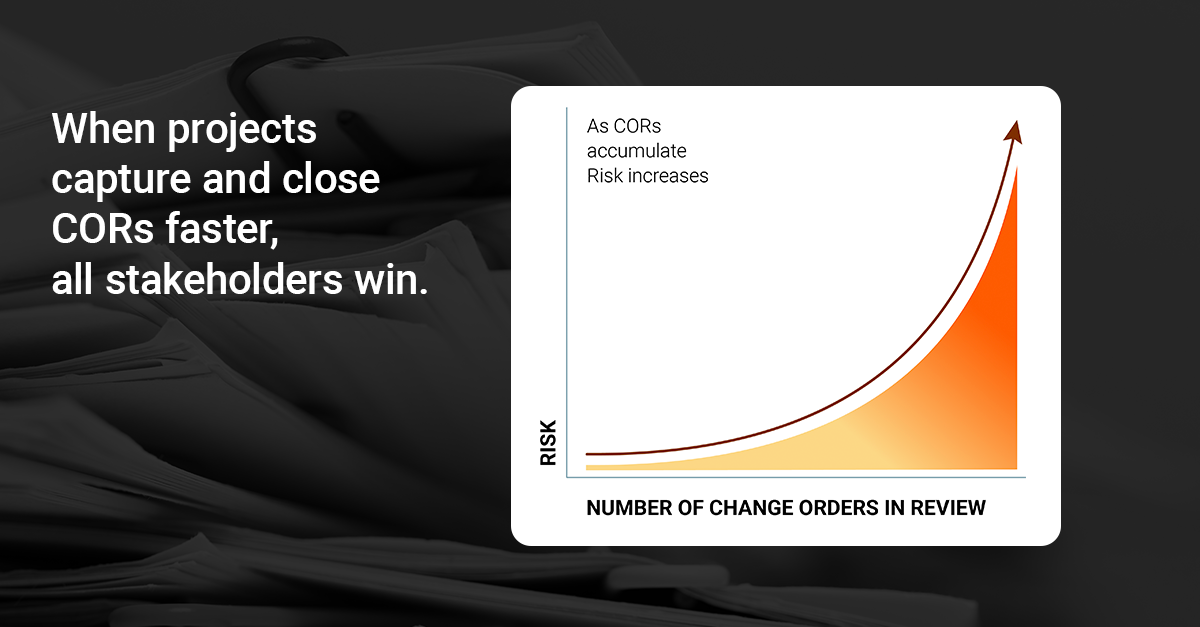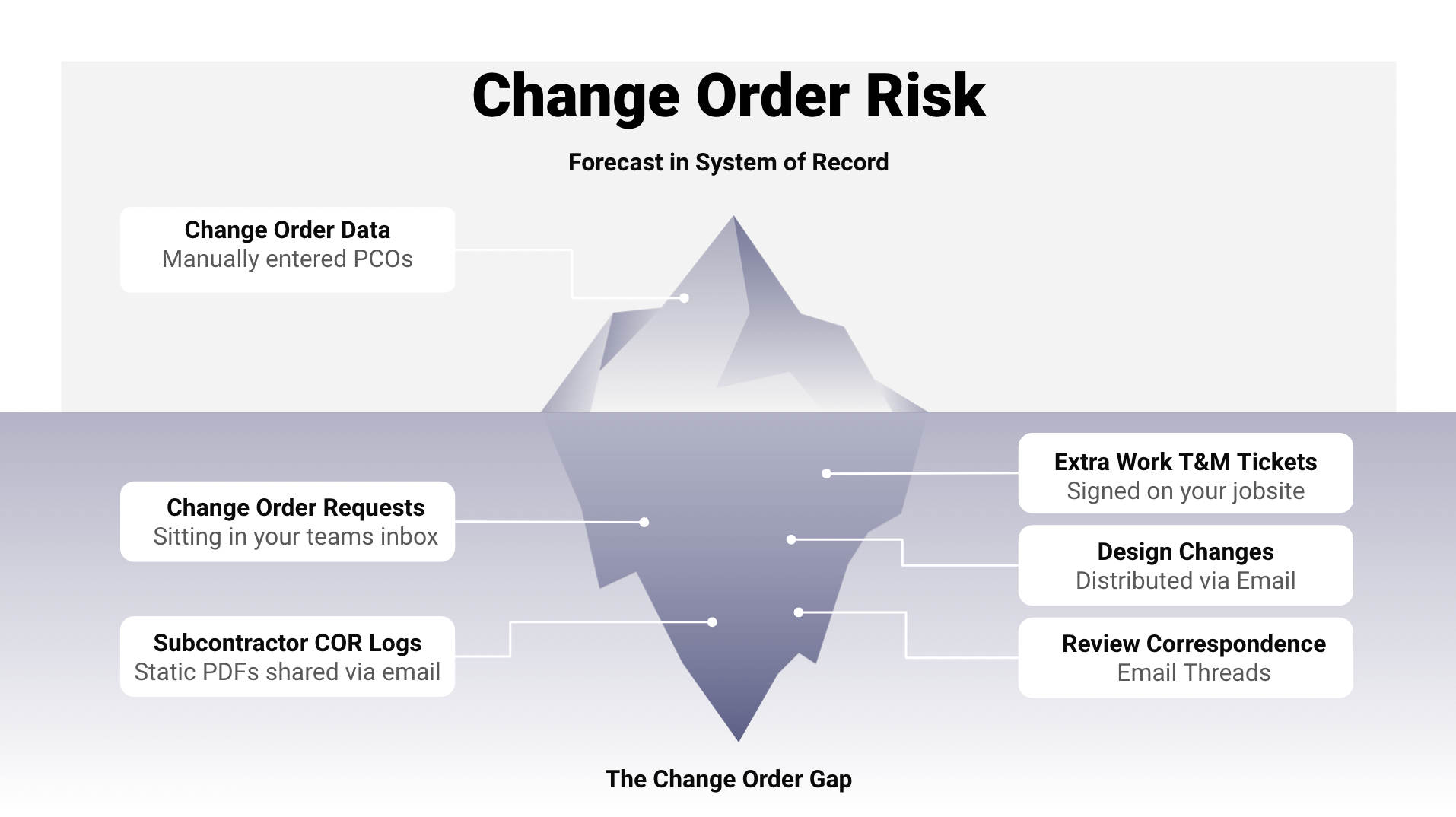In construction, as outstanding Change Orders accumulate on projects, risk goes up for all stakeholders.

For Specialty Contractors, this risk represents a delay or loss in billable revenue on out-of-contract work that they may have already performed on the project. In situations where CORs accumulate, they are left financing the work.
For General Contractors, accumulating Change Orders creates the risk of fee erosion and blind spots in their ability to forecast and help the clients make decisions.
For Project Owners, accumulating Change Orders turn into end-of-project surprise costs or disputes and limits the ability to make proactive and dynamic decisions to increase asset value.
So if all stakeholders benefit from resolving Change Order Requests faster, why is it so hard to accomplish? The answer lies in what we at Clearstory call: The Change Order Gap.
What is the Change Order Gap?
The Change Order Gap is the gap between everyone’s financial systems of record and the different software platforms where everyone tracks their own project budget. Systems of record should be private by design because they contain private financial information. But because of this, construction teams rely on external workflows to align on outstanding Change Order exposure and risk.
.png?width=1200&height=627&name=Change_order_gap%20(1).png)
The industry standard way Specialty Contractors, General Contractors, and Owners solve the Change Order Gap is by sending a static Change Order Log back and forth through email, exported from one system, or created in Excel and sent to the counterparty. The challenge with static COR logs and spreadsheets is that the moment they’re sent, they’re out of date. Not to mention that everyone has to ensure version control and save the corresponding documents to file folders, track down approval correspondence in email, and then reconcile it against the data in their system of record.
On top of sending static COR Logs back and forth, teams rely on email threads and manual PDF markups for Change Order Review, build email distribution lists for design changes and other pricing exercises, and use triplicate carbon copy for tracking T&M Tickets. It’s all just more emails, spreadsheets, screenshots, and attachments.
All of these workflows are used as an attempt to create the clarity needed to close the Change Order Gap, but routinely fall short, and even as project teams work frantically to ensure they have accounted for exposure, there’s often still uncertainty on what lies below the surface.

What's the Impact of the Change Order Gap on the Construction Industry?
- Wasted Employee Time: Because of the Change Order Gap, teams often spend more time organizing, creating, and finding Change Order Documentation than they actually do creating, reviewing, and managing Change Orders. This can lead to an insane amount of wasted hours, unnecessary stress, anxiety, and burnout for project teams.
- Revenue-at-Risk: As outstanding Change Orders accumulate on a project, Specialty Contractors bear the brunt of financing extra-work costs out-of-pocket. Without the immediacy and transparency of a real-time, universal COR log to keep everyone on the same page, Subcontractors and GCs negotiate outstanding Change Orders at close-out, sometimes contentiously, and often at a discount to the original out-of-pocket expense.
- Delays in Decision-Making: When design changes occur, it’s critical for GCs to collect and review cost impacts in order to help clients make fast decisions and keep projects moving. However, conducting pricing exercises through email can make it difficult to determine what pricing has been received, what has been reviewed, and what is complete enough for client review and approval, delaying the project schedule and ultimately impacting everyone’s financial position on the project.
- Payment Delays: When commercial construction stakeholders can’t share and resolve Change Order risk quickly, cash flow is stifled. Tracking T&M on paper, driving tickets back to the office for processing, and the time suck of requesting, revising, and marking up static COR logs via email all contribute to days aging on Change Order Requests. It can be weeks or even months of CORs navigating back and forth across the Change Order Gap before payment is approved.
- Limited Visibility: Since the Change Order Gap makes it hard to see Change Order Risk, General Contractor forecasts are vulnerable to gaps and blind spots. Without a real-time, accurate accounting of Change Order exposure from all trade partners, forecasts can’t account for unforeseen costs. This lack of visibility prevents GCs and owners from making practical and strategic decisions on how to allocate resources and take advantage of opportunities for design changes and project improvements. For Trade Partners, the lack of visibility can compromise the GC's ability to cover outstanding, accumulated CORs late in the project, jeopardizing the revenue the Trade Partner put at risk to complete extra work.
- Strained Relationships: Lack of transparency, limited visibility, and accumulating Change Order risk ultimately creates friction between project stakeholders. From lags in approving T&M tickets for field-directed work to delays in processing CORs for payment, to bargaining over outstanding Change Orders at close-out, the lack of a shared, real-time communication tool to bridge the Change Order Gap leaves everyone at the mercy of the status quo: contentious negotiations and hard feelings.
How Clearstory Solves the Change Order Gap
At Clearstory, our philosophy is that trust and transparency between stakeholders lead to better project outcomes. At the core of our product is a shareable, cloud-based Change Order Log so all stakeholders can have visibility into outstanding Change Order Risk instantly.
This Universal COR log is powerfully simple and can be set up on a project in minutes. The only change management required? Instead of emailing COR documents back and forth, you simply upload them into Clearstory, which automatically logs every COR and keeps an updated audit trail for all parties.
Want to see your risk exposure? Simply log in and see the status of all outstanding Change Orders in real-time. With the click of a button, you’ve solved the Change Order Gap.
On top of that, Clearstory offers a suite of tools and additional workflows to streamline the Change Order process between stakeholders:
- Change Order Review: All the tools are at your fingertips: ask questions, add comments, make redlines and callouts, and revise and resubmit in seconds without downloading a PDF, saving it in a file folder, and emailing documentation back and forth. Specialty Contractors are instantly notified of change requests by General Contractors and can submit revisions in real-time to drastically reduce the cycle time of Change Order review.
- Forward Price Changes: For design addendums, bulletins, and other forward price changes, Clearstory can send RFIs out to trade partners, set due dates for pricing, forecast costs, and pull all responses into the COR review process, dramatically boosting speed and increasing visibility.
- Field Directed Extra Work: For work tracked on the jobsite on a Time & Material basis such as trade damage, unforeseen conditions, overtime, etc., ditch the triplicate carbon copy paper tickets and use the Clearstory mobile app to easily and professionally photo-document work and request digital approval signatures. Every digital T&M Tag creates a PDF that’s instantly logged for both Specialty Contractors and GCs, so there’s never any surprises at the end of a project with outstanding T&M Tickets and unpriced Change Orders.
- Clearstory COR Templates: If you are looking to standardize Change Order Requests for your company or for all trade partners on a project, you can use Clearstory templates that easily break CORs down by labor, material, and equipment so everyone has a clear understanding of what the costs are. When COR documentation is consistent across all trades, GC and Owner review is dramatically faster, benefiting all parties.
- Real-Time Reporting and Insights: Aggregated reporting and project filters provide a holistic view of Change Order data across projects, allowing supervisors, project managers, and executives to pinpoint trends in what’s driving Change Orders and identify opportunities to prevent recurring errors for improved efficiency and happier, more collaborative teamwork.
By using Clearstory’s Universal COR Log and our collaborative suite of tools, all stakeholders win, and The Change Order Gap is closed. Regardless of what systems of record are in place for Specialty Contractor and General Contractor project management and project financials, Clearstory’s cloud-based tracking provides instant visibility into Change Order risk for all stakeholders:
- General Contractors avoid fee erosion from surprise costs, are able to forecast budgets with confidence and accuracy, and can dispense with manual processes and marginal communication paths that erode team efficiency and morale.
- Specialty Contractors capitalize on improved cash flow from speedier COR processing, reduce revenue-at-risk and strained relationships from forced negotiation on unseen Change Order risk, and boost jobsite productivity and morale by eliminating confusing and burdensome paperwork in the field.
- Project Owners gain greater visibility and confidence into project budgets to allocate resources and make strategic design/build decisions, avoid unforeseen extra costs at close-out, and enjoy better project collaboration and teamwork.
But the best part about Clearstory? It can be set up in minutes and learned even faster. Simply put, your teams are going to love it. With a simple, intuitive user interface and a purpose-built, focused design on Change Order Requests, there isn’t any clutter to get in the way of bridging the Change Order Gap.
Ready to Learn More?
If you're interested in gaining these benefits and closing The Change Order Gap on your next project, reach out to the Clearstory team today for a quick demo on how easy it is to get started.
